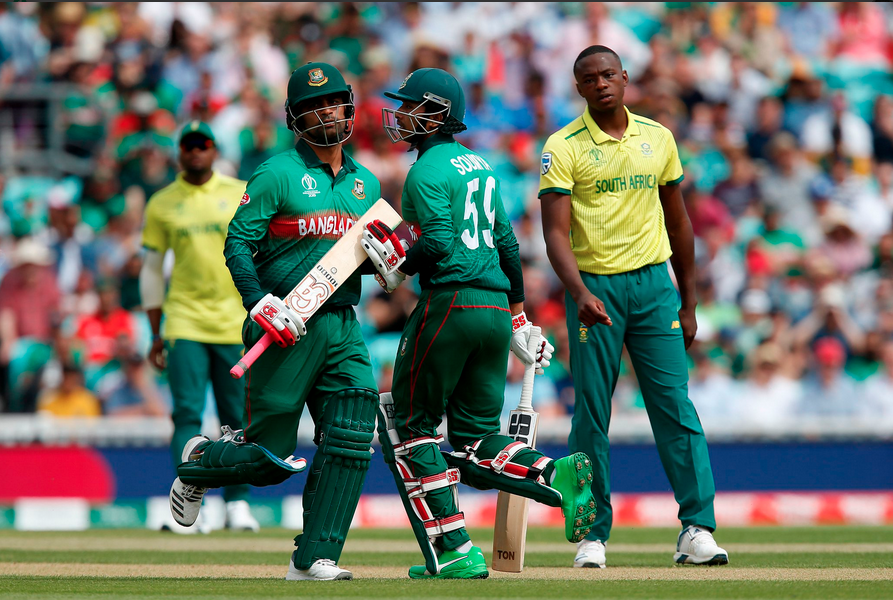A lack of creativity and energy across the middle overs has rendered the much-hyped Proteas attack largely impotent at this World Cup, writes JON CARDINELLI.
South Africa’s batting weaknesses have been exposed in the first two World Cup fixtures. Meanwhile, the bowlers and fielders have failed to show the necessary discipline and intensity needed to succeed at a tournament of this nature.
The Proteas have missed Dale Steyn, a world-class performer as well as a galvanising force within the team environment. They suffered another setback when Lungi Ngidi succumbed to a hamstring strain at the Oval on Sunday – a setback that forced a rethink regarding the bowling approach.
That said, there was a lot about the bowling performance against Bangladesh that put the previous showing against England into perspective.
GARY LEMKE: Fast bowlers lose plot as Proteas wilt again
Faf du Plessis was praised for winning the toss and opting to bowl first against England last Thursday. His charges were lauded for limiting a dangerous England batting lineup to 311-8.
On Sunday, Du Plessis decided to bowl first again. This time, the Proteas came in for heavy criticism after they allowed Bangladesh to post 330-6.
The Proteas leaked 54 runs in the final four overs. While the quality of the death bowling deserves scrutiny, one has to ask how Bangladesh found themselves in such a good position to launch in the latter overs.
The Tigers went into the final 15 overs with eight wickets in hand. They lost a couple of key players thereafter, but still had six wickets in the bank as the game moved into the final 10 overs.
How did they get to that point?
While Bangladesh deserve credit for their determination and application, the Proteas need to ask why they failed to pick up wickets in the middle overs, and why they needed more than 20 to break the 142-run partnership between Shakib Al Hasan and Mushfiqur Rahim.
LACK OF PENETRATION
Runs conceded to wickets taken by SA at 2019 World Cup
| OVERS: | 0-10 | 10-20 | 20-30 | 30-40 | 40-50 |
| vs ENGLAND | 60-1 | 52-2 | 58-0 | 65-1 | 76-4 |
| vs BANGLADESH | 65-1 | 64-1 | 66-0 | 54-2 | 86-2 |
While Du Plessis was praised for his tactics in the first innings of the opening game, the stats above show how South Africa struggled to penetrate the hosts between overs 20 and 40.
The Proteas didn’t concede a lot of runs during that period, and yet the failure to take wickets at regular intervals allowed England to set a platform for a late blitz.
The leadership wanted for ideas during that middle period. South Africa’s bowlers wanted for energy and intensity, and thus England were allowed to take control of the contest.
England were well set after 35 overs with seven wickets in the bank. They still had six to spare as the game moved into the final 10, and went on to score 76 runs in that period.
How does South Africa’s performance compare to other teams at the tournament? We’ve only had five matches to date, but there’s plenty of evidence to suggest that these English pitches have something in them for the bowlers, and the fast bowlers in particular.
SA BOWLING AT WORLD CUP
| vs ENGLAND | vs BANGLADESH | ||
| NGIDI | 3-66 (10) | 0-34 (4) | |
| RABADA | 2-66 (10) | 0-57 (10) | |
| PHEHLUKWAYO | 1-44 (8) | 2-52 (10) | |
| TAHIR | 2-61 (10) | 2-57 (10) | |
| PRETORIUS | 0-42 (7) | DNP | |
| DUMINY | 0-14 (2) | 0-10 (1) | |
| MARKRAM | 0-16 (3) | 0-38 (5) | |
| MORRIS | DNP | 2-73 (10) |
England had the means to penetrate South Africa in those middle overs. The Proteas cruised through overs 10 to 20 without losing a wicket, but then proceeded to lose three between overs 20 and 30 and five between overs 30 and 40.
West Indies hammered Pakistan thanks to a superb bowling performance. With Oshane Thomas leading the charge, the men in maroon bowled Pakistan out inside 22 overs. Subsequently, Pakistan took three wickets inside 11 overs before West Indies reached the small target.
New Zealand dominated against Sri Lanka, taking three wickets in the first 10 overs, three in the next 10, and then four between overs 20 and 30.
Australia took two wickets inside the first two overs, and a further two before the end of the 20th. They eventually bowled Afghanistan out inside 39 overs.
Why then are South Africa struggling to make serious inroads with the new ball, and why are they battling to penetrate teams in the middle overs?
ALSO READ: Ngidi ruled out of India clash
The Proteas’ batting issues run deep. Just lately, however, the bowlers have lacked intensity as well as discipline, and the poor bowling has been exacerbated by amateurish mistakes in the outfield.
It may be stating the obvious given the recent run of results, but if the Proteas fail to find their mojo in the next couple of matches, they will fall short of their playoff-qualification goal.
Photo: Cricket World Cup/Twitter







